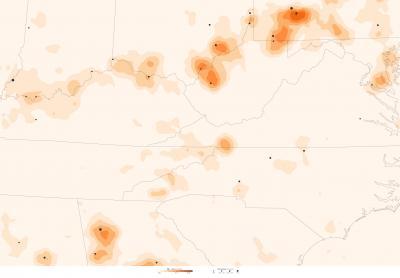Researchers using the Ozone Monitoring Instrument (OMI) on NASA's Aura satellite have confirmed major reductions in the levels of sulfur dioxide, a key pollutant generated by coal power plants which contributes to the formation of acid rain, in the eastern United States.
The analysis, the first satellite observations of this type, showed that sulfur dioxide levels in the vicinity of major coal power plants have fallen by nearly half since 2005, which confirms ground-based measurements of declining sulfur dioxide levels and demonstrate that scientists can potentially measure levels of harmful emissions throughout the world, even in places where ground monitoring is not extensive or does not exist. About two-thirds of sulfur dioxide pollution in American air comes from coal power plants.
The scientists attribute the decline in sulfur dioxide to desulfurization devices and other steps that limit the release of sulfur dioxide. The Clean Air Interstate Rule signed by the Bush administration in 2005 put a cap on emissions but left it up to power companies to determine how to reduce emissions. It also allowed companies to trade pollution credits.
Scientists had previously used the Ozone Monitoring Instrument to observe sulfur dioxide levels within large plumes of volcanic ash and over heavily polluted parts of China in the past but this is the first time they have observed such subtle details over the United States, a region that has relatively modest sulfur dioxide emissions compared to Asia. A few decades ago, sulfur dioxide pollution was quite severe in the United States but levels of the pollutant have dropped by about 75 percent since the 1980s, due largely to the Reagan administration signing the Clean Air Act.
A new mathematical approach made the improved measurements a reality. It centers on averaging measurements within a 30 mile radius (50 km) of a sulfur dioxide source over several years.

This map shows average sulfur dioxide levels measured by the Aura satellite for the period 2008-2010 over a portion of the eastern United States. The black dots represent the locations of many of the nation's top sulfur dioxide emissions sources. Larger dots indicate greater emissions. Credit: : NASA's Earth Observatory
The technique allowed the researchers to pinpoint the sulfur dioxide signals from the 40 largest sulfur dioxide sources in the United States, generally coal power plants that emit more than 70 kilotons of sulfur dioxide per year. The scientists observed major declines in sulfur dioxide emissions from power plants in Alabama, Georgia, Indiana, Kentucky, North Carolina, Ohio, Pennsylvania and West Virginia by comparing levels of the pollutant for an average of the period 2005 to 2007 with another average from 2008 to 2010.
"What we're seeing in these satellite observations represents a major environmental accomplishment," said Bryan Bloomer, an Environmental Protection Agency scientist familiar with the new satellite observations. "This is a huge success story for the EPA and the Clean Air Interstate Rule," he said.
The researchers focused their analysis on the United States to take advantage of the presence of a robust network of ground-based instruments that monitor sulfur dioxide emissions inside power plant smokestacks. The ground-based instruments have logged a 46 percent decline in sulfur dioxide levels since 2005, a finding consistent with the 40 percent reduction observed by OMI.
"Now that we've confirmed that the technique works, the next step is to use it for other parts of the world that don't have ground-based sensors," said Vitali Fioletov, a scientist based in Toronto at Environment Canada. "The real beauty of using satellites is that we can apply the same technique to the entire globe in a consistent way." In addition, the team plans to use a similar technique to monitor other important pollutants that coal power plants release, such as nitrogen dioxide, a precursor to ozone.
OMI, one of four instruments on the NASA Aura satellite, can measure sulfur dioxide more accurately than any satellite instrument flown to date. On July 6, 2011, the U.S. Environmental Protection Agency (EPA) finalized the Cross-State Air Pollution Rule (CSAPR), requiring 27 states to significantly reduce power plant emissions that contribute to ozone and fine particle pollution in other states. This rule replaces EPA's 2005 Clean Air Interstate Rule (CAIR).
Geophysical Research Letters published details of the new research.






Comments